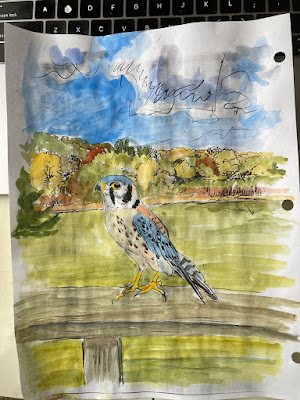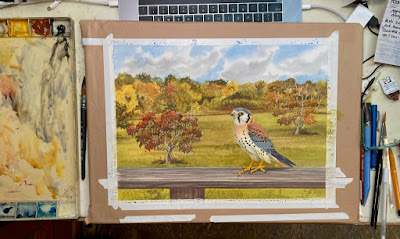The dwarf apple trees in the reference photo, which I intended to include so as to make the backyard recognizable, lacked a little in aesthetic impact, one having lost its leaves. I aged them by about 30 years , twisted their trunks, and clothed them in leaves, giving them probably more fall color than they would really have. Call it artistic license, to tart up some apple trees. I masked them with liquid masking compound and didn't remove it until I was all done with the forest and lawn. That turned out to be a good choice because I went over the lawn several times with large brushes and washes, trying to tame the green into something that would look nice with a kestrel's brilliant colors, and painting around those branches would have been a nightmare.
So it goes with my paintings…I make sure everything else is done before I get to start on the bird. But I have to keep backtracking. Once the deck railing went in, it mandated a lot more detail in the forest and the lawn, so there was a lot to do there. I knew that would happen. It's tough to have a super-detailed subject in the foreground and just haze out the background, unless you want it to look like someone’s photo.
I knew that the sky could make or break the painting. I didn’t want a super bright blue, and I wanted lots of clouds, to give it light and air. I wanted a feeling that the weather could change at any moment, the way it does in October. And like magic, when the clouds went in, the whole thing lightened up and you could see sunshine. I absolutely love painting clouds. I sketch them in pencil very loosely on the paper. Then, the trick is to get the paper as wet as you can. Then paint in the gray underbellies of the clouds, darker than you want them, because watercolor fades as it dries. Then, while everything is still sopping wet, get your brush loaded with blue and with the tip just tickle in the areas of blue sky, letting the blue spread and bleed into the white you’ve left around the cloud shadows. Voila. Try to avoid hard edges, but when you’re painting a big sky area, they happen while you’re busy somewhere else. That’s what makes it watercolor. Such a blast to paint cumulus clouds. You just have to wet that paper and let them happen. This medium was made for skies and clouds.
My best reference for skies turns out to be the photos I take many times yearly of the Three Graces. I found just the sky I wanted in this mid-October photo.
My client had a firm idea of what he wanted in the bird. He’d found a photo of a kestrel online with just the pose and attitude he wanted. While I liked the angle, and the bird was adorable, I wasn’t crazy about its overall condition. It looked rough to me, like it wasn’t getting the right diet. The jesses and the military uniform suggest it’s a mascot, not perhaps in the care of an active falconer who lets it hunt for fresh live food. So I went about improving its disheveled plumage texture and color and improving its soft part coloration, and redrew its wings and tail to make them more understandable to the viewer. (in this photo, the bird's tail is depressed straight down for balance, and the wingtips are a bit disordered). Mostly, I wanted my bird to look smooth and in perfect feather (wild), which the reference bird is clearly not. Here is a comparison photo to show you what I’m talking about.
All in all, it was a fun painting to do, a challenge to pull off; to walk that line between what the client asks me to do and what I might have chosen to do. This was more proscribed than the usual private commission, because it was important to the client that his backyard be recognizable. More than that, though, he also knew what he wanted for the bird and even supplied the reference photo. That doesn't happen very often. So my job as an artist who has accepted a specific commission was not to paint whatever I wished. My job was to set aside my own ideas about what would constitute an interesting kestrel painting, and work to make the best composition I could with what I was given. It’s a little like those TV chef challenges where you open up a refrigerator with four ingredients in it and are asked to make a dish of them. I feel that I cooked up something tasty. My client is thrilled with it because it’s faithful to his setting and has just the bird he wanted, and I had fun in my experimental watercolor kitchen. Win/win!
I think that, as a career illustrator, I am probably happier painting the occasional commission than many artists might be. I'm quite used to being asked to deliver a specific scene, behavior, event...it's a challenge I willingly accept. In some ways it's easier, more cut and dried, than dreaming up the most boffo "ideal" painting of a given species. That said, it's also great to have free rein, and artists given free rein tend to be happy artists. My choice is to be happy about whatever I'm doing, because painting watercolors in the comfort of my studio beats any number of alternatives I could name.
I'll leave you with a case of the warm fuzzies: what it was like to be painting one of my favorite birds for a wonderful client, on a snowy December afternoon.













8 comments:
Thank you for sharing your creative process with us. The painting is just lovely.
Just came on to comment and found that Crafty Jnet had shared the exact thing I was about to type. As a non-artist, at least in the sense of the plastic arts, it is fascinating to know the steps you take to get to the final painting. We outsiders never get to see that happening and it is a mystery to us.
Love your posts, Julie, especially this year :-). Happy holidays to you!
Lovely conversation, lovely artwork. Lovely way to start the day. Thank you.
Excellent post. I enjoyed reading about your process. I think kestrels are among our most beautiful birds!
These kinds of commissions are always challenging. While your client liked the pose of the tame bird on the officer's gloved hand, I find it rather stiff and unnatural. Your other photo example is much more realistic of a kestrel in the wild. It looks alive and dynamic. But in the end you have to please your client.
Many eons ago I was an Earthwatch volunteer for a project in the Goshute Mountains on the eastern edge of Nevada studying migratory patterns of hawks and eagles on the weastern flyway. I had the great honor of banding several kestrels and they are every bit as fantastic and unbelievable up close and personal as you say. Little gems that defy imagination.
Thanks Julie, I loved the blog and loved the video. What a safe and cozy world you have created for yourself to do your creative work and play in. Just lovely, thanks for the visit :)
Love kestrels and your painting of this one is gorgeous!
There is no doubt you have one happy client.
Someone you know!
Post a Comment